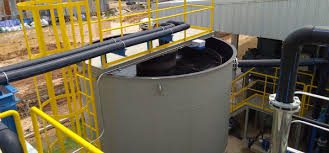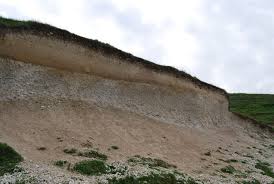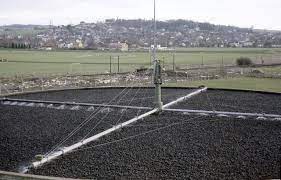Processes of Sludge Treatment
A lot of processes are at our disposal for the treatment of sludge as can be seen below.
1. Stabilization
Stabilization is the term used to denote the process of BOD reduction. Faecal sludge collected from bucket or vault latrines has a very high biochemical oxygen demand (BOD) and is generally putrid and odorous.
Primary and secondary sludges from an activated sludge treatment plant also have a high BOD and may be difficult to dewater.
Even sludge from a septic tank, which has undergone bacterial decomposition over at least a year, still has a high BOD. The stabilization process can be carried out under aerobic or anaerobic conditions.
Aerobic stabilization of primary and secondary sludges can be carried out in an aeration tank in the same manner as in an activated sludge process. Because of the high oxygen requirement, this process is energy intensive and costs are high.
Aerobic stabilisation requires less energy when carried out as part of a composting process. For composting of sludge, its solids content should be increased to at least 15 % so that it can be handled as a solid.
Thickening and dewatering of primary and secondary sludges are required to achieve the required solids content. Faecal sludge may contain high enough solids.
Mixing with dry materials such as dry sawdust may assist with achieving the required solids content as well attaining the required carbon to nitrogen ratio for composting.
2. Composting
Composting is an aerobic bacterial decomposition process to stabilise organic wastes and produce humus (compost). Compost contains nutrients and organic carbon which are excellent soil conditioners.
Composting takes place naturally on a forest floor where organic materials (leaf litter, animal wastes) are converted to more stable organic materials (humus) and the nutrients are released and made available for plant uptake.
The process is slow on a forest floor, but can be accelerated under optimum conditions. The optimum conditions for composting are moisture content of about 50 %, a carbon to nitrogen ratio of about 25 to 30, and temperature of 55 oC.
Because waste-water sludge is rich in nutrients, its carbon to nitrogen ratio is low (5 to 10). It is also high in moisture. Addition of dry sawdust, which is very high in carbon to nitrogen ratio (500), can adjust both the moisture and carbon to nitrogen ratio. Other waste materials that can be used for this purpose are mulched garden wastes, forest wastes and shredded newspaper.
Composting can be carried out in a specially built composter, such as an inclined rotating cylinder, fed on one end with the raw materials, and the aerated product collected at the other end.
As the materials are slowly tumbled over a period of about one week, they are mixed and aerated. Because bacterial decomposition produces heat, temperatures in the insulated composter can easily reach 55oC.
Read Also : Meaning and Generation of Sludge and its Importance
The immature compost is then windrowed for at least 12 weeks to allow the composting process to complete, with occasional turning of the windrow.

Composting can be more simply carried out in windrows as shown in the figure above. Regular turning of the windrows assists with mixing of the materials and more importantly supply the oxygen to the bacteria. Temperatures can reach 550C, because compost has a good heat insulating property.
Turning of the compost also ensures that all parts of the windrow reach the required 55oC essential for pathogen destruction. Turning is required every two to three days in the first two weeks when temperature is 55oC or above.
After this period frequent turning of the compost windrow is not required as less heat is generated and less oxygen is required while the compost undergoes maturation.
3. Anaerobic Digestion
Anaerobic digestion is a bacterial decomposition process that stabilizes organic wastes and produces a mixture of methane and carbon dioxide gas (biogas). The heat value of methane is the same as natural petroleum gas, and biogas is valuable as an energy source.

Anaerobic digestion is usually carried out in a specially built digester, where the content is mixed and the digester maintained at 35oC by combusting the biogas produced. After digestion the sludge is passed to a sedimentation tank where the sludge is thickened.
Biogas is collected from the digester as shown in the diagram above. The thickened sludge requires further treatment prior to reuse or disposal.
Anaerobic digestion can also be carried out at a slower rate in an unmixed tank or pond. Covering is usually by a UV resistant plastic sheet, because of the large area needed to be covered, and biogas is collected from the top of the sheet.
Storage of biogas can be in a cylindrical tank with a floating roof. The cylindrical roof floats on water and its position is determined by the volume of the gas stored under the pressure of the roof. Biogas can also be stored in a balloon, but only under low pressure.
In conclusion, from all that have been discussed so far, we can conclude by saying that sludge treatment is of high essence so that the recipient which is either land or sea do not suffer much harm by its introduction or presence, rather it will turn into a blessing, by providing nutrient to the new environments or by being reused for other purposes.
Read Also : How Creating Recyclable Products Support Effective Waste Management



